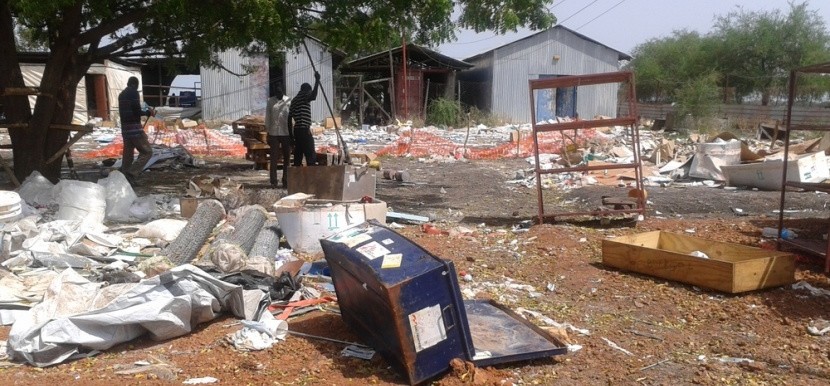Ceasefire monitors of the East African Inter-Governmental Authority on Development (IGAD) have blamed South Sudanese government forces for initiating recent fighting in southern Unity State, for looting medical supplies, for blocking a recent UN patrol out of Bentiu, and for the recent deaths of two civilians in Lelo in Upper Nile State.
A monitoring report released yesterday is the first in which IGAD monitors do not also list the rebel group SPLM/A-IO as the responsible party for any of the reported ceasefire violations. In their previous report the monitors blamed SPLM/A-IO for an attack on Guit last month.
According to the new report, on 29 September fighting broke out in the area of Leer. “All the evidence suggests that the fighting was initiated by Government Forces soldiers going out from Leer into the surrounding area where they took crops and livestock,” reads the report by the Joint Technical Committee of the IGAD Monitoring and Verification Mission.
“The villages the Government Forces went to included Pilling, Pawiny and Pullguare… Two clear facts which emerged during the investigation were firstly that the fighting started outside Leer in an area under the control of the SPLM/A-IO between government forces soldiers who were taking crops and livestock and SPLM/A-IO forces.”
In response to these forays by government forces, SPLM/A-IO forces attacked Leer on 2 October, briefly occupying it before being ejected by government forces, said the ceasefire monitors. On retaking the town the government forces “looted medical supplies and equipment from the premises of an international medical NGO.”
Following this looting, medical organizations evacuated from Leer. A health work said that this cut off “a vital lifeline to vulnerable populations suffering from malaria, malnutrition and other illnesses,” pointing out that there were no medical services left in Leer after the looting of the medical supplies.
Sporadic fighting continued in the Leer area until 5 October.
IGAD further claims that their ceasefire monitors were initially blocked from traveling to Leer from Bentiu together with a UNMISS patrol when government forces stopped the joint patrol on 8 October. It was not until 15 October that the ceasefire monitors were able to get a team to Leer to investigate.
The ceasefire monitors pointed out that at the time of the signing of the permanent ceasefire on 29 August the town of Leer was under the control of government forces, whilst the surrounding payams and Adok Port were under the control of the SPLM/A-IO.
Civilians witnesses have claimed that earlier this month that government forces also attacked numerous civilians in Leer County and caused the drowning deaths of 29 children who fled into swamps to hide from the attacks – a claim neither confirmed nor denied by the new IGAD report. A humanitarian group recently said that 80 civilians were feared dead in attacks this month in Leer County.
Separately, the IGAD monitors blamed government forces for an incident in which two civilians were killed, including a woman, in the Lelo area of Upper Nile State.
“On 27 September a Government Forces patrol was in the area of Lelo. There was some sort of engagement. In the engagement two people working in their fields were killed (one of whom was a woman) and another man injured. The MVT could find no evidence to suggest any SPLM/A-IO Forces were involved,” says the new report.
Major General Kisikia Ruet Puot, the acting commander of SPLA Division 2, told ceasefire monitors that one of their patrols involved with “reconnaissance duties” had been attacked by SPLM/A-IO forces. He denied any civilians were hurt.
IGAD contradicted this, citing interviews with local people and the injured man. The ceasefire monitors concluded that there was no evidence that rebel forces were involved in the incident. Instead, they reported that the civilians had seen government soldiers taking food and livestock and pointed out that those killed were civilians who were working in the fields.
“It was the assessment of the JTC that by sending out patrols into areas under the control of the SPLM/A-IO Government Forces were in violation of the PCTSA (Permanent Ceasefire and Transitional Security Arrangements). The fact that one of those killed was a woman – and therefore definitely a non-combatant – demonstrated in the very least a failure by the Government Forces involved to protect civilians.”
The report concludes, “Incidents such as the one that took place near Lelo on 27 September and which resulted in two people including a woman losing their lives would not happen if both Parties complied with the PCTSA and kept their forces in place and separated.”
In an email, the ceasefire monitors said that they were currently investigating additional violations.




